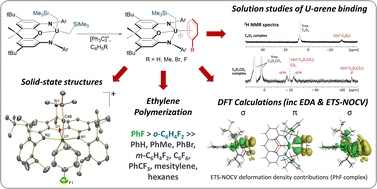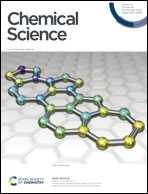Uranium(iv) alkyl cations: synthesis, structures, comparison with thorium(iv) analogues, and the influence of arene-coordination on thermal stability and ethylene polymerization activity†‡
Abstract
Reaction of [(XA2)U(CH2SiMe3)2] (1; XA2 = 4,5-bis(2,6-diisopropylanilido)-2,7-di-tert-butyl-9,9-dimethylxanthene) with 1 equivalent of [Ph3C][B(C6F5)4] in arene solvents afforded the arene-coordinated uranium alkyl cations, [(XA2)U(CH2SiMe3)(ηn-arene)][B(C6F5)4] {arene = benzene (2), toluene (3), bromobenzene (4) and fluorobenzene (5)}. Compounds 2, 3, and 5 were crystallographically characterized, and in all cases the arene is π-coordinated. Solution NMR studies of 2–5 suggest that the binding preferences of the [(XA2)U(CH2SiMe3)]+ cation follow the order: toluene ≈ benzene > bromobenzene > fluorobenzene. Compounds 2–4 generated in C6H5R (R = H, Me or Br, respectively) showed no polymerization activity under 1 atm of ethylene. By contrast, 5 and 5-Th (the thorium analogue of 5) in fluorobenzene at 20 and 70 °C achieved ethylene polymerization activities between 16 800 and 139 200 g mol−1 h−1 atm−1, highlighting the extent to which common arene solvents such as toluene can suppress ethylene polymerization activity in sterically open f-element complexes. However, activation of [(XA2)An(CH2SiMe3)2] {M = U (1) or Th (1-Th)} with [Ph3C][B(C6F5)4] in n-alkane solvents did not afford an active polymerization catalyst due to catalyst decomposition, illustrating the critical role of PhX (X = H, Me, Br or F) coordination for alkyl cation stabilization. Gas phase DFT calculations, including fragment interaction calculations with energy decomposition and ETS-NOCV analysis, were carried out on the cationic portion of 2′-Th, 2′, 3′ and 5′ (analogues of 2-Th, 2, 3 and 5 with hydrogen atoms in place of ligand backbone methyl and tert-butyl groups), providing insight into the nature of actinide–arene bonding, which decreases in strength in the order 2′-Th > 2′ ≈ 3′ > 5′.

- This article is part of the themed collection: 2022 Chemical Science HOT Article Collection


 Please wait while we load your content...
Please wait while we load your content...